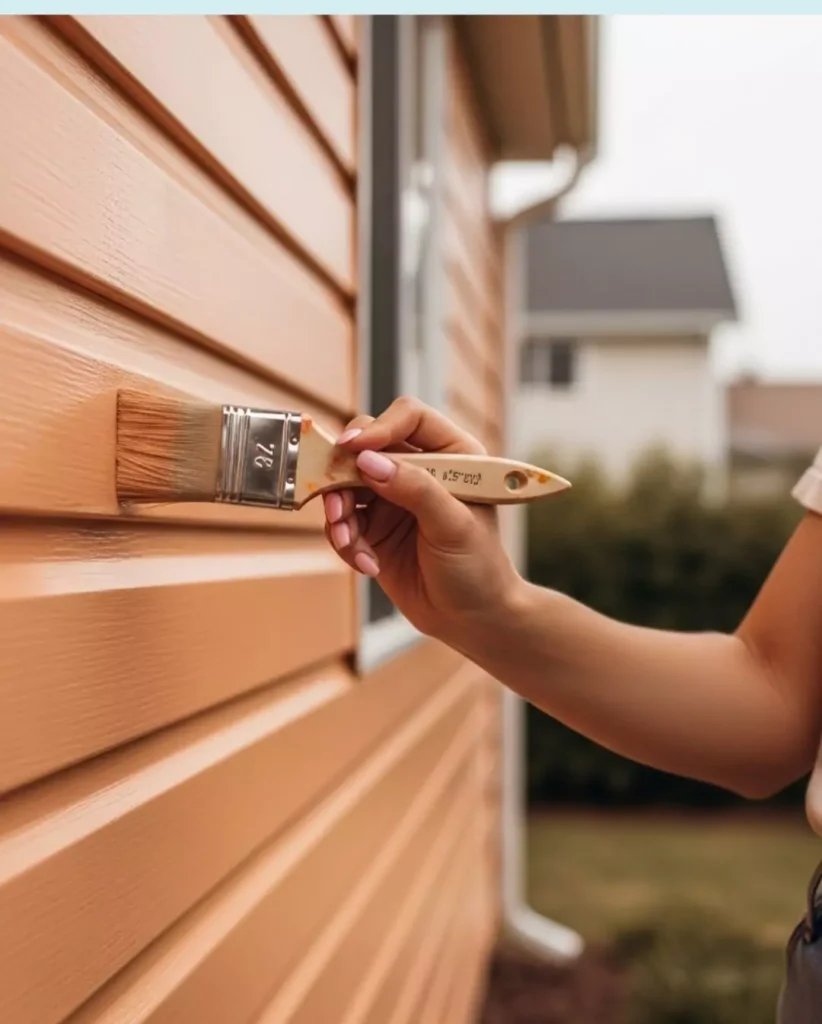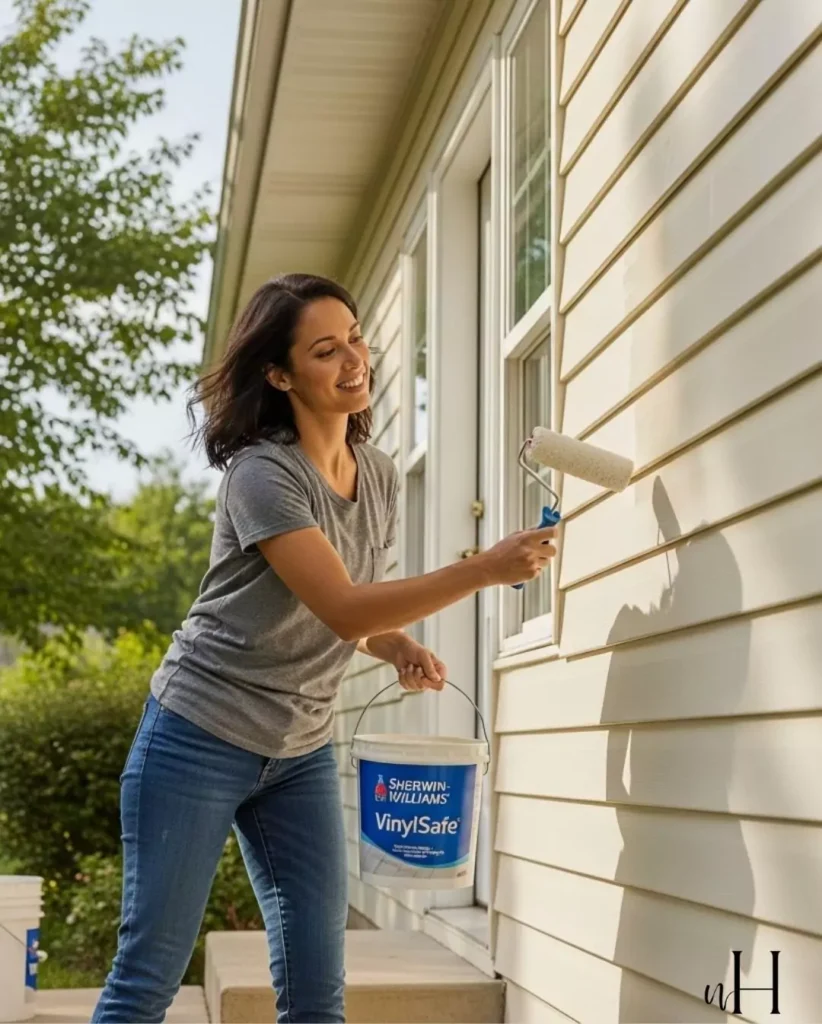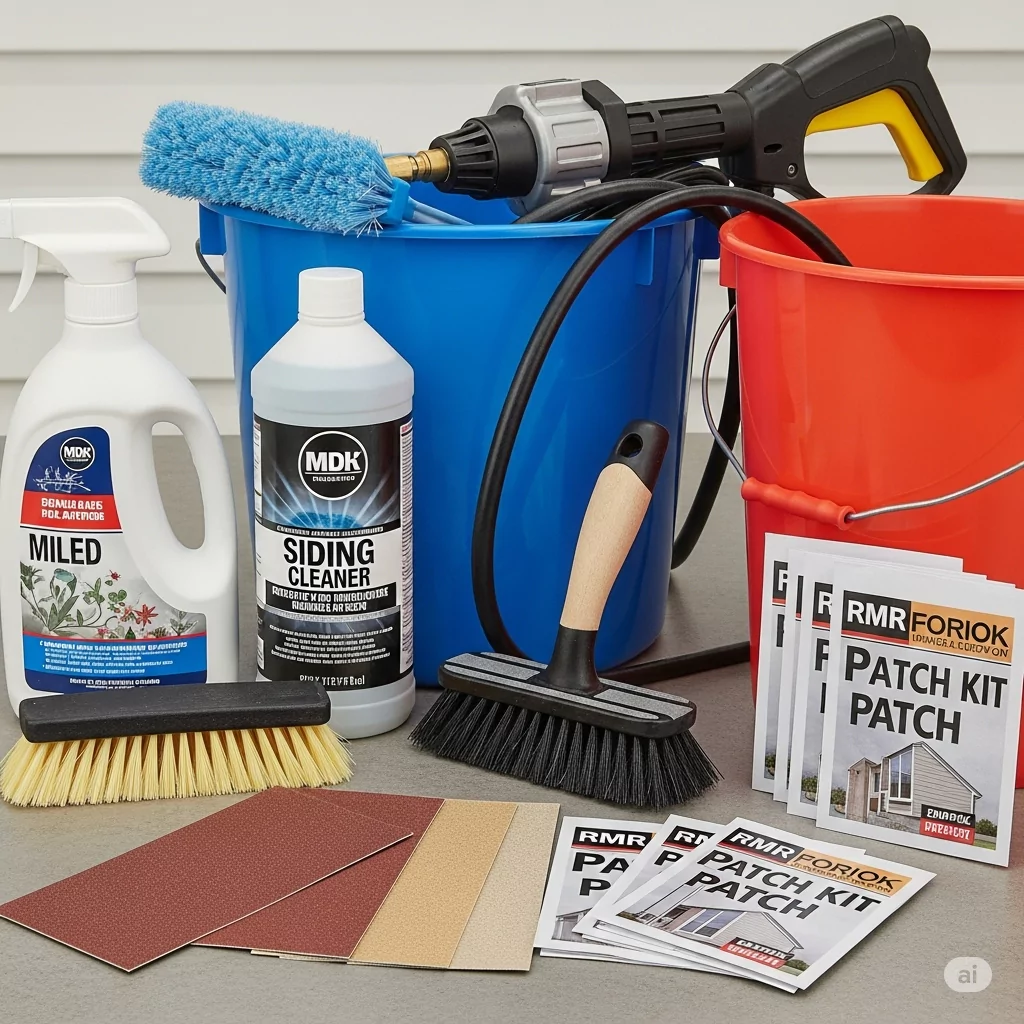Sometimes we get tired of looking at same exterior and the best thing we can do is to paint our Vinyl Siding to bring our exterior’s beauty back.
UMMMMMM….. because after winter we get some energy for DIY projects so I recently painted my home exterior and learned some lessons that I ‘ll love to share.
Sometimes, just slapping on a fresh coat of paint on your vinyl siding can totally bring it back to life and make your house look awesome from the outside. But hold up—before buying new paint I think there’s few things you need to learn about how to paint vinyl siding and what kind of paint you should use also ,do you need a primer?
Painting vinyl siding isn’t just some quick weekend thing. If you do it right, it can look amazing and last for years.
In this blog I’ve covered—everything from picking the right paint to prepping, priming, and nailing those final touches. By the time you’re done reading, you’ll either be ready to tackle the project head-on or at least sound like you know your stuff when you’re chatting about it over brunch.
Why Paint Vinyl Siding? Pros and Cons

You might be thinking, “Why not just replace my siding instead?” Fair question! Vinyl siding’s pretty tough, but after years in the sun, rain, and all that, it can start looking kinda old, faded, or just not the vibe you want for your house anymore.
Painting it’s a way cheaper and more eco-friendly option than replacing it. Plus, it saves your money and keeps more stuff out of the landfill. Win-win, right??
RELATED BLOG:
Benefits of Painting Vinyl Siding:
- Cost-effective makeover: A fresh coat of paint is often more affordable than siding replacement.
- Personalized color: Express your style with colors that pop or stay neutral with timeless shades.
- Durability enhancement: Quality exterior paint can add an extra layer of weather protection to your siding.
Choose the Right Paint for Vinyl Siding
Not all paints are created equal, especially when it comes to vinyl. Picking the wrong one can result in peeling, cracking, or poor adhesion.
What to Look for in Paint:
- Vinyl-Safe Formula: Look for paints labeled “vinyl-safe.” These are specially designed to adhere to the flexible nature of vinyl.
- UV Resistance: Siding is constantly exposed to the sun, so opt for a paint with fade-resistant properties.
- Light Reflective Value (LRV): Stick to lighter shades to avoid buckling. Dark colors absorb more heat, which can warp vinyl.
7 Recommended Paints for Long-Lasting Vinyl Siding Results:

- Sherwin-Williams VinylSafe
- Behr Premium Plus Ultra Exterior
- Benjamin Moore Regal Select Exterior
- Valspar Duramax Exterior Paint
- PPG Timeless Exterior Paint
- Rust-Oleum Zinsser Perma-White
- Glidden Premium Exterior Paint
Pro tip from experts at Sherwin-Williams: “While vinyl-safe formulas are key, always test your chosen paint on a small spot to check for adhesion before committing.”
What You’ll Need:

- Mild detergent or siding cleaner
- Power washer or a scrub brush with a bucket
- Sandpaper for rough spots
- Patch kits for cracks or damaged areas
Steps to Prep Your Vinyl Siding:
- Clean it:
First things first, get rid of all the dirt, mold, or whatever’s stuck on there. Just mix some water with mild soap or siding cleaner and scrub it down. Got a power washer? Use it on a medium setting (don’t go too hard!). For the stubborn stuff, grab a soft brush—it works wonders.
- Fix the damage:
Check your siding for any cracks or holes. If you see anything off, use a vinyl patch kit to fix it up. Don’t try to paint over damaged areas—it’ll just make things worse later.
- Dry it out:
Before you even think about painting, make sure the siding’s completely dry. Paint doesn’t stick to damp surfaces, trust me. Wait at least a full day after washing it.
Should You Prime your vinyl siding?
Some people say you don’t need to prime vinyl siding, but here’s the deal—if there’s bare spots, discoloration, or uneven areas, priming can really help the paint go on smoother and last longer.
How to Prime It:
- Pick a good primer: Don’t just grab any primer. Look for one that works with vinyl. Some good options are Zinsser Bulls Eye 1-2-3 or Kilz Premium.
- Go light: Don’t slap on thick layers; it’ll just add weight you don’t need. Use thin, even coats with a roller or sprayer for the best results.
And there you have it! It’s not rocket science, just take your time and you’ll get a great finish..
Painting Your Vinyl Siding
Now for the fun part (OK, it’s fun if you like painting). Applying the right techniques is essential for a flawless finish that lasts.
Painting Steps:
- Choose Your Tool:
If you’re in a hurry, a paint sprayer is super fast and covers evenly. But if you like more control, a brush or roller works great too.
- Do One Section at a Time:
Start at the top and work your way down. Focus on one section before moving to the next so you don’t end up with streaks everywhere.
- Go with Thin Layers:
Vinyl siding moves with the weather—it gets bigger and smaller depending on the temperature. So it’s better to do 2-3 thin coats instead of one thick one. Just let each coat dry properly before you slap on the next one.
- Don’t Forget the Edges:
Make sure to get the edges and corners for that clean, finished look. Use a small brush to get into those tight spots.
How Long Does the Paint Take to Dry?
When painting vinyl siding, drying time can vary depending on the weather and the type of paint used. On average, most exterior paints take about 4-6 hours to dry to the touch under ideal conditions—warm temperatures with low humidity.
However, for each coat to fully cure and set properly, it’s best to wait at least 24 hours before applying the next layer.
Be sure to check the manufacturer’s recommendations on the paint can, as faster-drying formulas or unique weather conditions might affect these timelines. Taking the time to allow proper drying ensures a smooth, durable finish that lasts.
Last Few Things to Do:
- Check for Spots You Missed: Walk around your house when there’s good daylight and check if you missed any spots.
- Clean Up Your Mess: Throw away leftover paint properly (follow the rules in your area) and clean your tools so they’re good to go for next time.
- Keep It Looking Fresh: Wash your siding at least once a year with a mild soap. Don’t go crazy with a pressure washer—keep it on a low setting.
Painting Vinyl Siding Is Worth the Effort
There’s something deeply satisfying about looking at your home and knowing you made it shine again. Painting vinyl siding is a project that requires patience, but the results are worth every minute.
Whether you’re taking on this DIY or hiring a professional, remember the key to success lies in prep, technique, and high-quality materials.
FAQS
How to remove paint from vinyl siding?
- Scrape off the loose stuff:
Grab a plastic scraper or even a putty knife and gently scrape off any loose paint. Don’t go crazy—just be careful not to scratch the siding. - Soap n’ water:
Mix up some warm water with dish soap (the regular kind from your kitchen) and scrub the painty spots with a soft cloth or sponge. This works pretty good for smaller spots. - Try some household stuff:
If the paint’s being stubborn, you can try rubbing alcohol, vinegar, or even a tiny bit of acetone. Test it first on a small hidden spot just to be safe! Then rub the paint gently with a cotton ball or cloth in circles. - Power washer (if needed):
If there’s paint all over, a power washer can help. BUT keep it on low so you don’t wreck the siding. - Rinse it all off:
When you’re done, rinse everything with clean water to get rid of any leftover soap or solvent.
How Long Does the Paint Take to Dry?
How long paint takes to dry kinda depends on what you’re painting, the type of paint, and stuff like temperature and humidity. Here’s a quick guide to help:
- Wood: If you’re painting wood, it usually dries in like 4-6 hours, but it might take up to a full day (24 hours) to fully cure. Oil-based paint takes longer, like 6-8 hours or maybe more. Just make sure the wood is clean and not wet before you start painting, otherwise it might not stick right.
- Metal: For metal, you’ll probably need a primer so the paint sticks better. Water-based paint dries on metal in about 2-4 hours, while oil-based ones take longer, like 6-8 hours or even more sometimes. Oh, and don’t forget to clean off any rust or dirt before you paint.
- Concrete: Concrete takes longer ‘cause it’s kinda porous. Acrylic paint dries in 4-6 hours for one coat, but it could take like 24-48 hours to totally cure. Make sure the concrete is all the way dry before painting or it might peel off later.
- Drywall: Paint on drywall dries pretty fast, usually like 1-2 hours if it’s water-based. Just check the label if you’re not sure about when to do the next coat. Using a primer before painting is a good idea so everything looks even.
Always check what the label says for drying times and don’t rush it! Letting the paint dry properly makes it look better and last longer..







